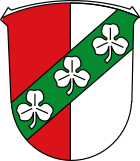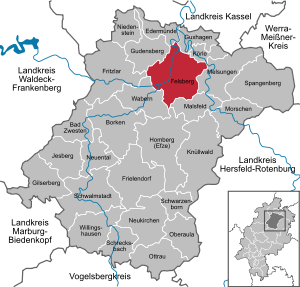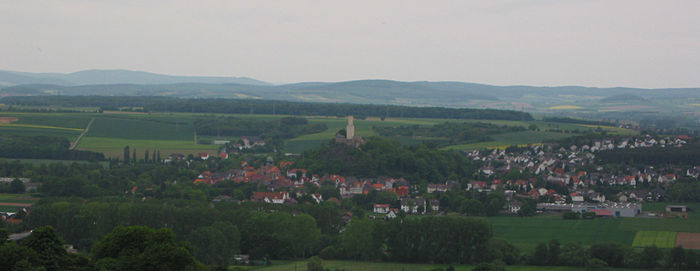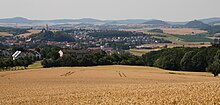Felsberg (Hesse)
| coat of arms | Germany map | |
|---|---|---|

|
Coordinates: 51 ° 8 ′ N , 9 ° 25 ′ E |
|
| Basic data | ||
| State : | Hesse | |
| Administrative region : | kassel | |
| County : | Schwalm-Eder district | |
| Height : | 162 m above sea level NHN | |
| Area : | 83.28 km 2 | |
| Residents: | 10,669 (Dec. 31, 2019) | |
| Population density : | 128 inhabitants per km 2 | |
| Postal code : | 34587 | |
| Primaries : | 05662, 05665 , 05683 | |
| License plate : | HR, FZ, MEG, ZIG | |
| Community key : | 06 6 34 003 | |
| LOCODE : | DE FSB | |
| City structure: | 16 districts | |
City administration address : |
Vernouillet-Allee 1 34587 Felsberg |
|
| Website : | ||
| Mayor : | Volker Steinmetz ( independent ) | |
| Location of the town of Felsberg in the Schwalm-Eder district | ||
Felsberg is a town in the Schwalm-Eder district in northern Hesse , a good 20 kilometers south of Kassel .
geography
The landscape around Felsberg is characterized by hills and small ponds as well as remnants of gravel mining .
As part of the West Hessian depression , it is located in a depression area formed during the Tertiary . The change between partly basaltic hills and flat river valleys is distinctive. While the valleys are covered by fluvial sediments , there is fertile loess cover in the higher areas . The city of Felsberg is traversed by the Eder . The Heiligenberg with the ruins of Burg Heiligenberg and the ruins of the former Carthusian Monastery of Eppenberg lie above the district of Gensungen .
In the district of Böddiger is the Böddiger Berg , the northernmost officially recognized vineyard in Hesse and the northernmost economically operated vineyard in the old federal states of Germany. The location on the Eder is one of the first ecological vineyards in Germany. The Böddiger Berg belongs to the Rheingau wine-growing region .
Neighboring communities
Felsberg borders in the north on the communities Edermünde , Guxhagen and Körle , in the east on the town Melsungen , in the south on the community Malsfeld and the town Homberg (Efze) , and in the west on the community Wabern and the towns Fritzlar and Gudensberg (all in Schwalm-Eder district).
City structure
The city of Felsberg has 16 districts:
|
history

The late Ice Age settlement of the Felsberg region can be proven by the 12,000 year old find of the so-called skull of Rhünda .
In the 1st century the area settlement area was the Germanic tribe of the chat . The only mention of the area from this period is an account of a Germanicus campaign that destroyed Mattium , the main Chatti town , in 15 AD . From the 8th century at the latest, the area of the Chatten was part of the Franconian Empire .
In the area of the city are the ruins of three castles, the Felsburg , the Altenburg in the Altenburg district, and the Heiligenberg Castle above the Gensungen district on the opposite bank of the Eder . For this reason, Felsberg has been sometimes referred to as the "Three Castle Town" since 1974, as both Altenburg and Gensungen have belonged to the town since 1974. The castles were built because of their strategically important location in the Middle Ages , between the Archdiocese of Mainz and the Landgraviate of Thuringia and Hesse . Heiligenberg Castle belonged to Mainz, while Felsburg and Altenburg belonged to Hesse. Both the Felsburg and Altenburg, two kilometers away, are characterized by their striking towers (popularly known as butter churn ). The salt road led from the Werra , where the salt was extracted, via Felsberg into the Rhineland .
In 1090 Felsberg is mentioned under the name Velisberc in a Mainz document, as well as in 1209 in an inventory of the Fritzlar Petrus pen . The first documented mention of Felsberg as a town was in 1286. The historic town center was surrounded by a town wall 830 meters long since the 13th century , some of which is still preserved today. From 1455 to 1488 the alchemist Klaus von Urbach worked on the Felsburg to produce gold there at the behest of the Landgrave. Around 1510 Euricius Cordus Rentschreiber was in Felsberg.
During the time of the Napoleonic Kingdom of Westphalia (1807-1813) Felsberg was the administrative seat of the canton Felsberg .
On November 8, 1938 a day earlier than most other places in Germany, there was a Gau from the Kurhessen the Nazi -controlled pogrom against the 18, then alive, nor in Felsberg Jewish people . The seriously ill Robert Weinstein became the first victim of this orgy of violence in Kurhessen. He was dragged out of bed, beaten and driven through the streets. He died of a heart attack.
During the Second World War , parts of Felsberg were severely damaged by the bombing of the Gensungen train station and the destruction of the Edertalsperre .
Territorial reform
In order to professionalize the administration, to create better coordination and coordination possibilities for larger planning areas and the realization of the principle of equality , the Hessian administrative and territorial reform was carried out. The first phase in 1971 and 1972 was the voluntary amalgamation of the municipalities. This was also promoted by financial benefits from the state. On January 1, 1974, the last five municipalities were incorporated by state law, including Brunslar and Gensungen . At the same time Felsberg switched to the newly established Schwalm-Eder district . Local districts were established for all incorporated, formerly independent communities .
| Former parish | date | annotation |
|---|---|---|
| Altenbrunslar | 1st February 1971 | Merger with Neuenbrunslar to form Brunslar |
| Altenburg | December 31, 1971 | |
| Beuern | December 31, 1971 | Incorporation according to Gensungen |
| Böddiger | 1st February 1971 | Merger to form the expanded city of Felsberg |
| Brunslar | 1st January 1974 | Renewed amalgamation by state law to form today's town of Felsberg |
| Gensings | 1st January 1974 | |
| Helmshausen | 1st January 1974 | |
| Hesserode | 1st February 1971 | Incorporation according to Gensungen |
| Hesslar | 1st February 1971 | Incorporation according to Gensungen |
| Hilgershausen | 1st January 1974 | |
| Lohre | 1st February 1971 | Merger to form the expanded city of Felsberg |
| Melgershausen | April 1, 1972 | Incorporation according to Gensungen |
| Neuenbrunslar | 1st February 1971 | Merger with Altenbrunslar to Brunslar |
| Niedervorschütz | December 31, 1971 | |
| Rhünda | 1st January 1974 | |
| Wolfershausen | December 31, 1971 | Incorporation to Brunslar |
politics
City Council
The local elections on March 6, 2016 produced the following results, compared to previous local elections:
| Parties and constituencies |
% 2016 |
Seats 2016 |
% 2011 |
Seats 2011 |
% 2006 |
Seats 2006 |
% 2001 |
Seats 2001 |
||
|---|---|---|---|---|---|---|---|---|---|---|
| SPD | Social Democratic Party of Germany | 50.3 | 16 | 50.3 | 19th | 53.9 | 20th | 59.8 | 22nd | |
| ULF | Independent list Felsberg | 20.5 | 6th | - | - | - | - | - | - | |
| CDU | Christian Democratic Union of Germany | 18.6 | 6th | 21.6 | 8th | 23.8 | 9 | 24.3 | 9 | |
| FDP | Free Democratic Party | 7.0 | 2 | 4.9 | 2 | 5.7 | 2 | 5.8 | 2 | |
| DFB | The free citizens | 3.6 | 1 | 4.4 | 1 | 5.2 | 2 | - | - | |
| GREEN | Alliance 90 / The Greens | - | - | 14.5 | 5 | 6.4 | 2 | 5.8 | 2 | |
| FWG | Free community of voters | - | - | 4.4 | 2 | 5.0 | 2 | 4.4 | 2 | |
| total | 100.0 | 31 | 100.0 | 37 | 100.0 | 37 | 100.0 | 37 | ||
| Voter turnout in% | 56.9 | 58.0 | 58.9 | 66.7 | ||||||
mayor
Mayor Volker Steinmetz (independent) has been in office since April 1, 2008. He was elected in a runoff election on November 11, 2007 with a share of 67.6% of the vote. On March 31, 2008 the term of office of the long-time mayor Klaus Stiegel ( SPD ), who served for 24 years, ended.
coat of arms
The city coat of arms has been known since 1570 when it was shown at Rotenburg Castle . It was published in 1633 in the Hessian Wappenbuch by Wilhelm Wessel.
Town twinning
There are city partnerships with Vernouillet ( France ) and Cheddar ( England ), as well as friendship agreements with Felsberg (Saar) , Felsberg ( Graubünden ) and Dingelstädt ( Thuringia ).
Culture and sights
Museums
- Beekeeping Museum of the Felsberg district beekeeping association in the gatehouse of the former monastery of Carthusian monastery Eppenberg am Heiligenberg.
- Museum of Prehistory and Early History in the Gensungen district
Art trail
- The Ars Natura project was started in 2001 east of Felsberg and is being expanded in sections into a 700 km long art hiking trail.
Buildings
- Old town: The small half-timbered old town lies below the ruins of the rock castle.
- Evangelical town church: The church with the low nave and the higher choir was built in the middle of the 15th century, its west tower in the middle of the 14th century. In 1640 parts of the nave were given a flat ceiling.
- Felsburg : The castle ruins are enthroned on a rugged basalt rock above the old town. The ring wall with the castle chapel and the keep have been preserved . The tower, built in 1388, is popularly known as the "butter churn"; it can be "climbed" via steep wooden stairs.
- Heiligenburg Castle on the Heiligenberg in the Gensungen district (ruin with observation tower).
- Altenburg : Castle ruins in the Altenburg district.
Sports
- Handball game community ESG Gensungen / Felsberg
- Football club FV Felsberg-Lohre-Niedervorschütz
- Sports club TSV Eintracht 1863 Felsberg
Economy and Infrastructure
- On the Main-Weser-Bahn (Kassel – Frankfurt) line, Felsberg is served by the train station in Gensungen and the stops in the Altenbrunslar and Wolfershausen districts.
- The 180 km long Eder cycle path runs along the Eder . It begins in the Rothaargebirge in North Rhine-Westphalia and is called Ederauenweg here . The largest part leads through Hesse and is then called the Eder cycle path . It follows the course of the Eder to its confluence with the Fulda (river) at Grifte .
- Felsberg had its own city savings bank from 1848 to 2017 .
Personalities
This overview contains both important personalities who were born in Felsberg as well as people who worked in Felsberg but were not born here. The list does not claim to be complete.
- Peter Barthelmey (1945–2019), handball player and coach, made promotion to the Bundesliga in 1978 as a player-coach with TSV Jahn Gensungen
- Markus Berger (1974), writer
- Hans von Boineburg-Lengsfeld (1889–1980), officer; lived and died in the Altenburg district
- Benjamin Bramer (1588–1652), artist, architect, builder, geodesist, mathematician
- Günter Böttcher (1954–2012), German handball player and coach and university lecturer
- Heinrich Clobes (around 1880 - around 1935), inventor of a mechanical street sweeper
- Georg Coch (1842–1890), economist and banker, founder of the Austrian Postal Savings Bank
- Johannes Combach (1585–1651), philosopher and theologian; 1625 preacher in Felsberg
- Euricius Cordus (1486–1535), poet, rent clerk for the landgrave widow Anna at the beginning of the 16th century
- Leopold Fleischhacker (1882–1946), sculptor
- Egbert Hayessen (1913–1944), resistance fighter; grew up in the 1920s on the Mittelhof in Gensungen.
- Bernd Hering (1924–2013), painter, graphic artist, sculptor, lived and worked from 1985 to 2010 in Felsberg
- Walter B. Loewenstein (1926–2018), American physicist, emigrated in 1938, born in Gensungen
- Jutta Meyfarth (* 1927), opera singer
- Burkhart Prinz (1939–2014), high school teacher, handball player and trainer, national youth trainer of the DHB
- Erich Schnepel (1893–1986), Protestant pastor and writer
- Klaus von Urbach , alchemist; worked in Felsberg from 1455 to 1488
- Franz Wagner (* 1948), former German handball player, active for Eintracht Felsberg, TSV Jahn Gensungen and HSG Gensungen / Felsberg
literature
- Kurt Schilde : Early November pogroms 1938 and the first victim Robert Weinstein. Berlin 2016, ISBN 978-3-95565-169-5 .
- Bettina Toson: Medieval hospitals in Hesse between Schwalm, Eder and Fulda. Hessian Historical Commission Darmstadt and Historical Commission for Hesse, Darmstadt / Marburg 2012, ISBN 978-3-88443-319-5 .
- Literature on Felsberg in the Hessian Bibliography
Web links
- Internet presence of the city of Felsberg
- Illustration by Daniel Meisner from 1624: Felsberg; Discordia Res Magnæ Dilabuntur ( digitized version )
Individual evidence
- ↑ Hessian State Statistical Office: Population status on December 31, 2019 (districts and urban districts as well as municipalities, population figures based on the 2011 census) ( help ).
- ↑ In historical documents the place name appears in alternating spellings: Velisber (1090), Filisberg (1100), Veilsberg (1160), Welsberc (1238), Velsberc (1247) and Velsberg (1333 and 1360). "Felsberg, Schwalm-Eder district". Historical local lexicon for Hesse (as of February 27, 2014). In: Landesgeschichtliches Informationssystem Hessen (LAGIS). Hessian State Office for Historical Cultural Studies (HLGL), accessed on July 10, 2014 .
- ↑ In memory of Robert Weinstein, the city of Felsberg inaugurated Robert Weinstein Platz in Untergasse on November 8, 2013. ( http://www.synagogue-center-felsberg.org/?page_id=82 )
- ↑ a b c d e f Law on the reorganization of the districts Fritzlar-Homberg, Melsungen and Ziegenhain (GVBl. II 330-22) of September 28, 1973 . In: The Hessian Minister of the Interior (ed.): Law and Ordinance Gazette for the State of Hesse . 1973 No. 25 , p. 356 , § 18 ( online at the information system of the Hessian state parliament [PDF; 2,3 MB ]).
- ^ Federal Statistical Office (ed.): Historical municipality directory for the Federal Republic of Germany. Name, border and key number changes in municipalities, counties and administrative districts from May 27, 1970 to December 31, 1982 . W. Kohlhammer, Stuttgart / Mainz 1983, ISBN 3-17-003263-1 , p. 404-405 .
- ↑ a b Municipal area reform: mergers and integration of municipalities from January 20, 1971 . In: The Hessian Minister of the Interior (ed.): State Gazette for the State of Hesse. 1971 No. 6 , p. 248 , item 328, para. 47 ( online at the information system of the Hessian state parliament [PDF; 6.2 MB ]).
- ^ Result of the municipal election on March 6, 2016. Hessian State Statistical Office, accessed in April 2016 .
- ^ Hessian State Statistical Office: Result of the municipal elections on March 27, 2011
- ^ Hessian State Statistical Office: Result of the municipal elections on March 26, 2006
- ^ Runoff election of the mayor of Felsberg on November 11, 2007 ( Memento of December 7, 2007 in the web archive archive.today )









